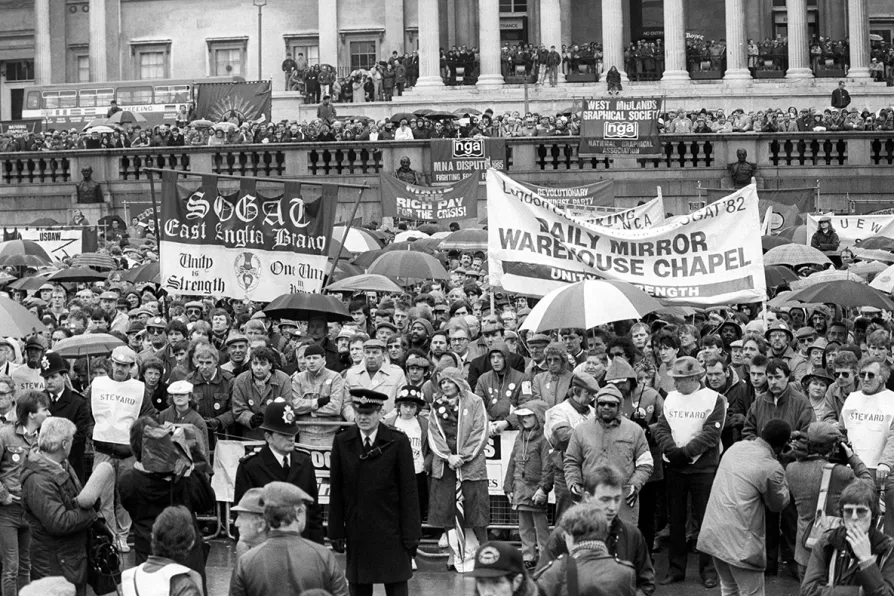10 years ago this month, Corbyn saved Labour from its right-wing problem, and then the party machine turned on him. But all is not lost yet for the left, says KEITH FLETT
Print workers have been fighting for their rights for centuries. But despite the huge progress they have made, the battle’s far from over, says ANN FIELD

 Crowds assembled in Trafalgar Square, London, for the union rally in support of the workers sacked in the print union dispute with Rupert Murdoch's News International, April 1986
Crowds assembled in Trafalgar Square, London, for the union rally in support of the workers sacked in the print union dispute with Rupert Murdoch's News International, April 1986
TWO HUNDRED YEARS of struggle and progress for jobs, better conditions and justice for workers were put into reverse by government-promoted attacks in the 1980s. Still in operation today are those same laws curtailing workers’ collective rights.
Solidarity action at work remains forbidden, indeed the concept of solidarity in general has been effectively outlawed, witness imprisonment of environment and Palestine activists.
Print and other workers began their struggles hundreds of years ago. In defence of jobs and communities or pursuit of better conditions, print and paperworkers were transported or jailed.
The first recorded strikes of bookbinders, compositors, printers and papermakers took place in the 1780s and 1790s. Despite legal repression workers’ mobilisation began to emerge during the early 19th century.
The first recorded agreement in papermaking, the Rochester Resolutions was made in 1804; the first scale of prices (wages) for compositors was determined by employers in 1785, but not until 1847 was it negotiated by the trade union and employers representatives. These scales were accepted within the trade as the norm: employers that did not observe them were deemed to be unfair, and union members were encouraged not to seek employment with them. Print companies struck off the “fair list” for around 100 years for failure to comply included The Times, and Spottiswoods the parliamentary printer.
Craft print unions, formed during the 1800s, included rule book provision for rates of pay and regulation of apprentice numbers. Throughout the century there were at least as many disputes and strikes against wage undercutting and reduction as for advancement in conditions.
The 30-week strike by London bookbinders in 1839 resulted in recognition of their right to combine, reduction in the number of apprentices (used to undercut adult pay) and withdrawal of prosecutions.
As print and paperworker trade union membership expanded among non-craft workers demand intensified for better working hours and conditions, inspired by the nine-hour movement in other industries. In 1911 after a fierce struggle a landmark agreement established steps towards a 48-hour week and settlement of disputes by conciliation.
Propelled by the mass struggles of workers during the first world war and Establishment fears of revolution, the Whitley report to the government recommended trades across all industries form joint industrial councils. Councils were formed for the printing industry and for papermaking.
The Paperworkers’ Charter of 1919 established minimum rates of pay and reduction in hours for all paper mill workers including non-craft for the first time.
In strikes of 120,000 workers over a six-week period in 1959, print unions achieved the first 40-hour agreement for manual workers; later the 37.5-hour week in 1982. Two hundred years to halve the working week.
By mid-century most printworkers, union and non-union, and almost all national newspaper employees, benefitted from terms and conditions of employment negotiated by the unions. But extended battles took place over pay and conditions for non-craft workers with particular pay and discrimination barriers for women in the industry to overcome.
Printworkers used their industrial strength in support of other workers in struggle: strike action to release dockers imprisoned in Pentonville 1972; the 1982 TUC Day of Action in support of health workers and the NHS. The Upper Clyde Shipbuilders occupation of the shipyards in 1971 inspired the occupation at Briant Colour Printing in 1972.
Notable examples of national newspaper workers using their strength to protest about scurrilous reporting in the press included railway workers 1919, miners in 1926 and again in 1984, Grunwick workers in 1977.
Media owners led the vicious, unremitting campaigns against the unions, in support of the incoming 1979 Tory government. The struggle to save jobs across many industries and sectors during this period drew in hundreds of thousands of workers. Entire workforces were destroyed, collective agreements on pay, conditions, rights of representation and recognition were unilaterally ripped up by employers great and small.
The Tory government aimed to crush miners’ and printworkers’ trade unions supported by financiers, employers and the media. The Wapping dispute exploded within nine months of the end of the miners’ strike, and less than two years after the end of the Stockport Messenger dispute.
Egged on by other media owners, right-wing journalists and academics, Rupert Murdoch’s News International found a way to get rid of an entire unionised workforce. Supported by a chorus falsely denouncing Luddite printers opposing the advance of new technology and printers challenging editorial and press freedom, a strike was provoked to justify dismissal of 5,500 workers.
Nine decades of pay and conditions agreements were abolished. Trade union rights, organisation and customs were dissolved which had been present in the printing industry for two centuries. Despite no reinstatement or recognition by News Corp, Unite GPM&IT members fight on for rights and better conditions in the industry. Commemoration of the 40th anniversary of the ensuing 13-month dispute will take place next year 2026.
In one of a series of history sessions launched by the GFTU, the long experience of trade union organisation in the printing industry is being examined this week at the Marx Memorial Library.










